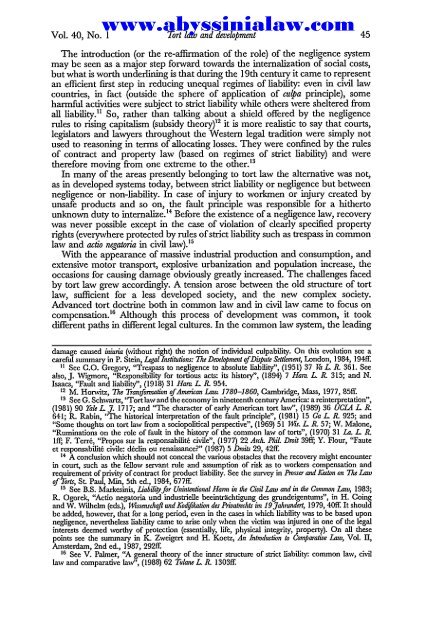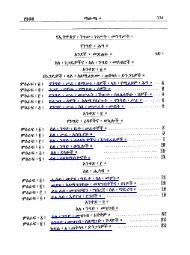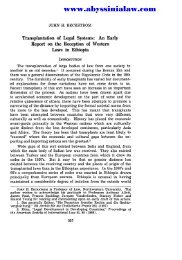Download - Abyssinia Law
Download - Abyssinia Law
Download - Abyssinia Law
You also want an ePaper? Increase the reach of your titles
YUMPU automatically turns print PDFs into web optimized ePapers that Google loves.
Vol. 40, No. I Tort law and development<br />
www.abyssinialaw.com<br />
The introduction (or the re-affirmation of the role) of the negligence system<br />
may be seen as a major step forward towards the internalization of social costs,<br />
but what is worth underlining is that during the 19th century it came to represent<br />
an efficient first step in reducing unequal regimes of liability: even in civil law<br />
countries, in fact (outside the sphere of application of cu/pa principle), some<br />
harmful activities were subject to strict liability while others were sheltered from<br />
all liability. So, rather than talking about a shield offered by the negligence<br />
rules to rising capitalism (subsidy theory) 2 it is more realistic to say that courts,<br />
legislators and lawyers throughout the Western legal tradition were simply not<br />
used to reasoning in terms of allocating losses. They were confined by the rules<br />
of contract and property law (based on regimes of strict liability) and were<br />
therefore moving from one extreme to the other.' 3<br />
In many of the areas presently belonging to tort law the alternative was not,<br />
as in developed systems today, between strict liability or negligence but between<br />
negligence or non-liability. In case of injury to workmen or injury created by<br />
unsafe products and so on, the fault principle was responsible for a hitherto<br />
unknown duty to internalize. 4 Before the existence of a negligence law, recovery<br />
was never possible except in the case of violation of clearly specified property<br />
rights (everywhere protected by rules of strict liability such as trespass in common<br />
law and actio negatoria in civil law).'<br />
With the appearance of massive industrial production and consumption, and<br />
extensive motor transport, explosive urbanization and population increase, the<br />
occasions for causing damage obviously greatly increased. The challenges faced<br />
by tort law grew accordingly. A tension arose between the old structure of tort<br />
law, sufficient for a less developed society, and the new complex society.<br />
Advanced tort doctrine both in common law and in civil law came to focus on<br />
compensation. 6 Although this process of development was common, it took<br />
different paths in different legal cultures. In the common law system, the leading<br />
damage caused iniuria (without right) the notion of individual culpability. On this evolution see a<br />
careful summary in P. Stein, Legal Institutions: The Development of Dispute Settknt, London, 1984, 194ff<br />
" See C.O. Gregory, "Trespass to negligence to absolute liability", (1951) 37 Va L. R. 361. See<br />
also, J. Wigmore, "Responsibility for tortious acts: its history", (1894) 7 Ham L P. 315; and N.<br />
Isaacs, "Fault and liability", (1918) 31 Ham L R. 954.<br />
12 M. Horwitz, The Transfornation of American Losa 1780-1860, Cambridge, Mass, 1977, 85ff.<br />
Bs See G. Schwartz, "Tort law and the economy in nineteenth century America: a reinterpretation",<br />
(1981) 90 rae L. J. 1717; and "The character of early American tort law", (1989) 36 UCLA L. R.<br />
641; R. Rabin, "The historical interpretation of the fault principle", (1981) 15 Ga L. R. 925; and<br />
"Some thoughts on tort law from a sociopolitical perspective", (1969) 51 Wis. L. R. 57; W. Malone,<br />
"Ruminations on the role of fault in the history of the common law of torts", (1970) 31 La. L R.<br />
1ff, F. Terr6, "Propos sur la responsabilit6 civile", (1977) 22 Arch. Phil. Droit 39ff; Y. Flour, "Faute<br />
et responsabilit6 civile: d~clin ou renaissance?" (1987) 5 Dmts 29, 42ff.<br />
14 A conclusion which should not conceal the various obstacles that the recovery might encounter<br />
in court, such as the fellow servant rule and assumption of risk as to workers compensation and<br />
requirement of privity of contract for product liability. See the survey in Prosser and Keeton on 7he <strong>Law</strong><br />
of Torts, St. Paul, Min, 5th ed., 1984, 677ff.<br />
15 See B.S. Markesinis, Libili for Unintentional Hann in the Civil <strong>Law</strong> and in the Common <strong>Law</strong>, 1983;<br />
R. Ogorek, "Actio negatoria und industrielle beeintrttchtigung des grundeigentums", in H. Coing<br />
and W. Wilhelm (eds.), Wusenschafi und Aodrlkation des Privatrchtis ir 19ahrundert, 1979, 40ff. It should<br />
be added, however, that for a long period, even in the cases in which liability was to be based upon<br />
negligence, nevertheless liability came to arise only when the victim was injured in one of the legal<br />
interests deemed worthy of protection (essentially, life, physical integrity, property). On all these<br />
points see the summary in K. Zweigert and H. Koetz, An Introduction to Comparative <strong>Law</strong>, Vol. II,<br />
Amsterdam, 2nd ed., 1987, 292ff<br />
16 See V. Palmer, "A general theory of the inner structure of strict liability. common law, civil<br />
law and comparative law", (1988) 62 Tulane L. R. 1303ff.





